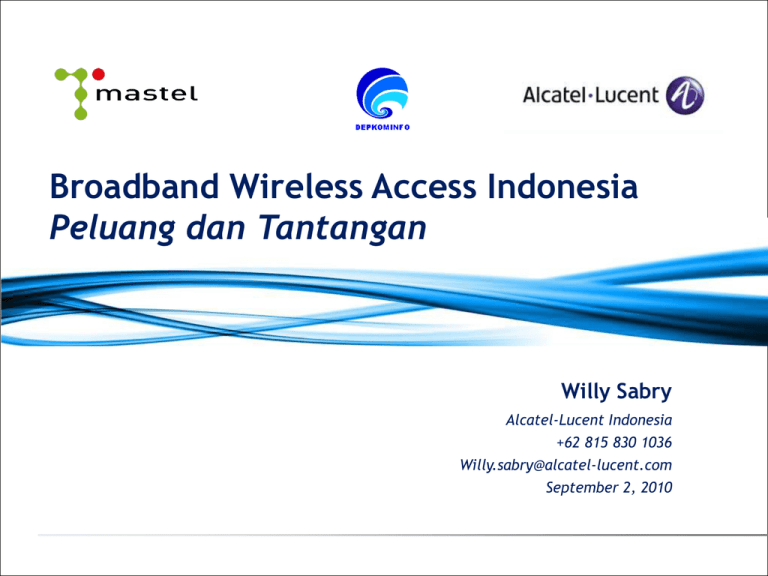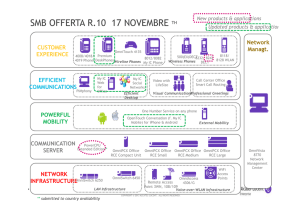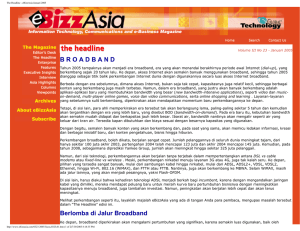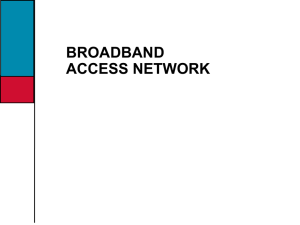
Broadband Wireless Access Indonesia
Peluang dan Tantangan
Willy Sabry
Alcatel-Lucent Indonesia
+62 815 830 1036
Willy.sabry@alcatel-lucent.com
September 2, 2010
Agenda
1. Broadband in Indonesia
2. Technology choice and network economy
3. Summary
All Rights Reserved © Alcatel-Lucent 2010
1. Broadband In Indonesia
Objectives
DGPT Study Group 4G
Mastel
RPJMN (2014)
1. Increase penetration
ICT for prosperity and welfare
1. Internet penetration: 50%
2. Affordability
1. Increase penetration
2. Broadband: 30%
3. Drive National Industry
2. Affordability & quality service
3. Digital TV program: 35%
4. Optimum spectrum value
3. Effective public services
4. Backbone main islands: 100%
4. Reduce social inequality
5. Broadband for cities / regency capital:
75%
BROADBAND
Users expectation:
Coverage, Services/Quality, Affordability
Why Broadband:
National Infrastructure, knowledge based society, 1.3% PDB increase
for every 10% broadband penetration increase, National
Competitiveness index
All Rights Reserved © Alcatel-Lucent 2010
Broadband in Indonesia
Today
Extreme Rural
Dense
Urban
• Land Area: 1.9m km2, 17,508 islands
• 240 million Population
• 33 provinces, 500 cities / regency
capital
• 6000 municipal
• 70000 villages
• 62 million household
Rural
Urban
Suburban
Broadband Services today:
• In Dense urban / Urban area, ~ 30 cities.
• Penetration: 1% WBB, 0.7% FBB, 4% PC
(household basis), 68% Mobile phone
• HSPA, EVDO, WiMAX, DSL, PON, HFC
• Best effort
Source: Pyramid, ALU
All Rights Reserved © Alcatel-Lucent 2010
Broadband in Indonesia
Expectation & Challenges
Extreme Rural
Dense
Urban
Rural
Urban
Suburban
Broadband for All
Expectation:
• Coverage (30%-40% area)
• Services/ Quality (voice-data-multimedia
/ best effort - QoE guaranteed ubiquitous)
• Affordability (most competitive in the
region)
All Rights Reserved © Alcatel-Lucent 2010
Challenges:
• Technology / solution mix:
access/backbone, wireline / wireless, FO
/ radio
• Economic: PNBP vs PDB increase /
National infrastructure / ICT fund
• Regulation / Industry Structure
Coverage
… with the right technology mix being a combination of fixed & wireless
Extreme Rural
Dense
Urban
Rural
Urban
Suburban
Note: Sample cost model Australia
Wireline (eg FTTx, DSL, GPON)
and Wireless (LTE, HSPA,
EVDO, WIMAX)
Wireless technologies at
low frequency bands (eg
LTE, HSPA, EVDO)
Wireline complements Wireless in
Urban Areas
Satellite
Rural area more suitable with Wireless
transport network – FO backbone, combination FO/MW backhaul
All Rights Reserved © Alcatel-Lucent 2010
Coverage
… although mobile is the preferred broadband technology in emerging
markets, it will eventually need to be completed with fixed technologies
Broadband
Bandwidth per user (Mbps)
DVB
Density (users/sqkm)
0,1
2
8
16
64
100
0,2
0,3
0,4
0,5
SD TV
1
Wireless only
2
5
HD TV
7,5
10
12,5
Wireless + Satellite
200
Fibre + FTTN
400
800
DSL CO +
LTE/WiMAX/FTTN
1000
•
•
•
Mobile Broadband is a quick and easy approach to address broadband demand – but limited to
maximum throughput
Fixed technologies scale better for high density areas and greater bandwidth demand
Optimum solution is a combination of multiple technologies
All Rights Reserved © Alcatel-Lucent 2010
Service / Quality
Broadband for socio economic development
Residential Services
Metros
Metropolitan
Security
High-Speed Internet
VPN, Web services
Unified communications
Collaboration tools
Mobility and teleworking
Campus and building
surveillance
Hospitality
Utility metering
Cloud computing
Symmetrical, Business Critical / SLG,
Ubiquitous
Symmetrical, Business Critical / SLG
Asymmetrical
High-speed Internet
Video conference /
telephony over IP
IPTV (Interactive TV, 3D
TV, Web TV)
Home surveillance, Home
automation
Fixed-mobile convergence
Social Networking
Public Services
Business Services
Information
Public safety
Closed-circuit TV
Emergency
e-learning
e-healthcare
e-social care
e-administration
One-stopadministration portal
Highways
Buses
Ports
(Container tracking)
All Rights Reserved © Alcatel-Lucent 2010
High-Voltage
pôles Utilities
Data Acquisition
& control
Oil & Gaz
(Dwelling)
Affordability
Development synergy
Investment (%)
100%
Retail,
Service
applications,
Network,
infra resources
Access
to public
infrastructure
Market Driven
e.g. Tier 1 cities
Retail, service
applications
Retail, Service
applications,
Network
Network &
IP Wholesale
Optional:
IP Wholesale
Optional: Dark
fiber roll-out
Dark fiber roll
out and renting
Labeling / Pre
cabling
Gov’t /
Public
Labeling / Pre
cabling
Sector
Access
to public
infrastructure
Buildof Primary
infra
Risk Driven
Policy Driven
e.g. Tier 2 & suburban
e.g. rural
BSO ICT fund NBN ???
Halaman 10
Private
Sector
All Rights Reserved © Alcatel-Lucent 2010
Area
types
Affordability
Infrastructure / Network Sharing, Services Competition
End-user
Retail Services
(residential, public & business)
Active Network
(network equipments, business & operation support)
Passive Infrastructure
(tower, sites, trenches, ducts, fibre)
Services
competition
Infrastructure
/ Network
sharing
Halaman 11
All Rights Reserved © Alcatel-Lucent 2010
2. Technology choice and network economy
End-to-end Broadband Wireless Access
Next-gen Wireless Broadband – Exploit QoE for effective Services
Radio Access Network
Evolved Packet Core
•2/3/G, LTE (Large & Small Cell), WiMAX,
Satellite
•S-GW, P-GW
•MME, PCRF
•FTTx, MetroE Access
access
Backhaul /
aggregation
Core / Edge
MME
BTS
2G+3G+LTE
SGW
2G/3G Core
(Circuit &
Packet)
SDE
OSS/BSS
Subs.Data Mgmt
PCRF
PGW
Backbone
transport
IP/MPLS
SDP: IMS, Mobile TV
optics
Transport
Service Delivery Environment
•Aggregation / Backhaul
• IMS, SDP, OSS/BSS, payment and
security
•Backbone
All Rights Reserved © Alcatel-Lucent 2010
Broadband Wireless Access
technology is converging toward LTE
A common evolution path…
GSM/UMTS
HSPA+
GSM/EDGE
UMTS/HSPA+
…highly efficient technologies
L
GSM/EDGE
TD-SCDMA
T
1xRTT
OFDM
MIMO
Flat IP
Robust
modulation
Increased link
capacity
Flat, scalable
E
1x/Do-R.A
1x/Do-R.A
3G
B/A+
WIMAX
700 MHz
5MHz
10MHz
4G
Operating bandwidth options
TDD / FDD
LTE bandwidth options,
highly Spectrum efficient
1.4MHz 3MHz
“3.9G”
850 MHz
900 MHz 1.9/2.1 GHz 2.1 GHz
2.3 GHz
20MHz
QoE guaranteed - Multiservices
All Rights Reserved © Alcatel-Lucent 2010
Eco-system – NGMN, LSTI
2.6 GHz
Impact of signal strength and concurrent users to throughput
…performance by throughput per subscriber instead of peak BW per BS –
network design & dimensioning is critical
Halaman 15
All Rights Reserved © Alcatel-Lucent 2010
Impact of standards & frequency on network economy
2500 Mhz band require 4.5 X higher capex than 700 MHz band
800 MHz
12
1500%
1400%
10
1230%
1300%
8.9
Typical Cell Ranges for LTE show a
significant advantage of using
lower frequencies
Better indoor penetration
Relative Capex (%)
1200%
10
1100%
8
1000%
900%
800%
5.5
4.7
700%
675%
6
3.9
600%
455%
500%
2.9
4
328%
400%
300%
200%
Cell Radius (km)
2.6 GHz
Relative CAPEX and typical cell radius to cover a certain
area in suburban environment as a function of the
frequency band used for deployment
100%
126%
700 MHz
850 MHz
2
100%
0
0%
1900 MHz
2500 MHz
3500 MHz
5800 MHz
Frequency Deployment
Source: Business case summary for NGMN - Milan Sallaba
All Rights Reserved © Alcatel-Lucent 2010
Wireless device reality for 2009-2014
LTE device overall price trend
LTE/HSPA/GSM Multi mode
LTE Single Mode
Device
Categories
Handsets
Targeted Timeline
- June2011 -
$344
CPEs
Targeted Timeline
- March2011 -
$220
$140
$220
USB Sticks
/ Modems
$150
$124
Targeted Timeline
- March2011 -
$200
$150
PCI Express
$105
(Embedded
modules)
Targeted Timeline
- March2011 -
$183
$138
0
50
100
150
200
250
300
350
400
450
Estimated
Price Range
Initial Trends as of February 2010
Price decrease for entry range products expected in 2011 due to economic of scale
All Rights Reserved © Alcatel-Lucent 2010
3. Summary
Broadband for All
Broadband for prosperity and welfare
Coverage
a holistic Network
and Economic
Analysis would be
necessary
Service / Quality
Residential Services
Public Services
Business Services
High-Speed Internet
VPN, Web services
Unified communications
Collaboration tools
Mobility and teleworking
Campus and building
surveillance
Hospitality
Utility metering
Cloud computing
Symmetrical, Business Critical / SLG,
Ubiquitous
Symmetrical, Business Critical / SLG
Asymmetrical
High-speed Internet
Video conference /
telephony over IP
IPTV (Interactive TV, 3D
TV, Web TV)
Home surveillance, Home
automation
Fixed-mobile convergence
Social Networking
Affordability
Information
Public safety
Closed-circuit TV
Emergency
e-learning
e-healthcare
e-social care
e-administration
One-stopadministration portal
BSO ICT fund NBN ???
Metros
Metropolita n
Security
Highwa ys
Buses
Ports
(Conta iner tra cking)
High- Volta ge
pôles Utilities
Da ta
Acquisition &
control
Oil & Ga z
(Dwelling)
All Rights Reserved © Alcatel-Lucent 2010
Services
competition
Infrastructure
/ Network
sharing
Broadband Wireless Access
Right choice of BWA technology would benefit Indonesia
All Rights Reserved © Alcatel-Lucent 2010
www.alcatel-lucent.com
Pemakaian frequensi TV Broadcast di Indonesia
45
40
35
30
25
TV
20
15
10
5
0
BABEL
JAMBI
LAMPUNG
RIAU
SUMSEL
BANTEN
DKI
JAKARTA
JAWA
TENGAH
KALBAR
KALTENG
All Rights Reserved © Alcatel-Lucent 2008, XXXXX
BALI
NTT
SULSEL
SULTRA
IRJABAR
MALUKU
UTARA



